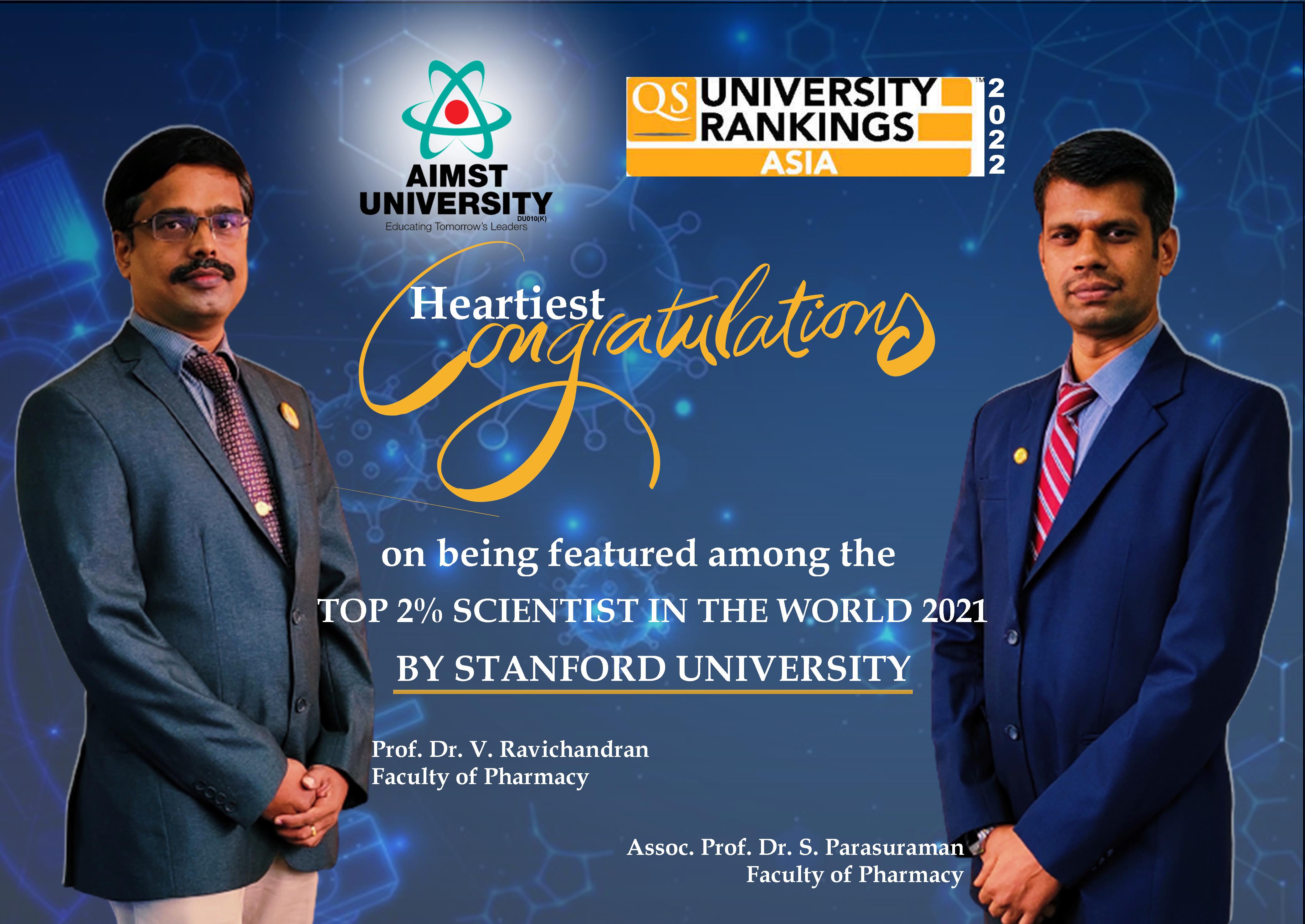6 Ways We can dwell on Positives during the Pandemic
Professor Kevin Fernandez from the Faculty of Medicine AIMST University has outlined six ways to live on positively during the Covid-19 pandemic to counter negative thinking that people have these days in an article titled ‘6 ways we can dwell on positives during the pandemic.’ The write-up got featured in NST’s ‘Letters to the Editor’ column on 10 November 2021. Click HERE to read.
MOA & MOU SIGNING CEREMONY
AIMST Corporate Communication [video width="640" height="352" mp4="https://aimst.edu.my/wp-content/uploads/2021/11/MOA-MOU-Signing-Ceremony.mp4"][/video]
MOA & MOU SIGNING CEREMONY
AIMST University and three notable organisations, namely Mont Royale College (MRC), Kuala Lumpur, Luoyang Normal University (LYNU), Henan in China, and the Chinese Chamber of Commerce and Industry of Central Kedah (CKCCCI), inked Memorandum of Agreement (MOA) and Memorandum of Understanding (MOU) on Wednesday, 10 November 2021.
The event was organised by the Business Development Unit (BDU) and was hosted by the Vice-Chancellor & Chief Executive of AIMST University, Prof. Datuk Dr. John Antony Xavier. Witnessing the signing ceremony were members of AIMST University's senior management team and members from the media.
Welcoming the collaborations to foster learning experience and professional development, Prof. Datuk Dr. John Antony Xavier said the collaborations would also initiate joint projects, expertise sharing, and exchange of ideas. It will also facilitate research and curriculum development, especially with Mont Royale College and Luoyang Normal University.
Mont Royale College (MRC) is a 5-Star My Quest (Excellent) rated institution. Through the MOA, the college will conduct AIMST University's Bachelor of Science (Hons) in Business and Marketing, Bachelor of Science (Hons) in Finance and Management, and Bachelor of Science (Hons) in Accounting and Finance on a collaborative franchise model in 2022. The delegation from MRC was led by its President, Mr. Sugumaran Chellaya, and accompanied by its CEO, Ms. Shamini Velayalhan, and the college principal Ms. Fazlin Noor Sahroni along with four other key management staff.
Luoyang Normal University will collaborate on several projects such as students and staff mobility, R & D, and conduct AIMST University's Bachelor of Science (Hons) in Biotechnology on a collaborative franchise model. LYNU was represented by Mr. Darren Teh from Henan Wanyu Education Technology Ltd., a consulting agency appointed by LYNU for the MOU signing ceremony.
The Chinese Chamber of Commerce and Industry of Central Kedah inked MOU with AIMST University to provide platforms for industrial visits, internships, and job placements for AIMST University students and graduates with I.R 4.0 industry-readiness apart from conducting joint-seminars, lectures, and talks. Moreover, the MOU will enrich its members' knowledge and skills with vast educational opportunities and lifelong education with AIMST University. CKCCCI was represented by its President, Mr. Lee Mern Hau, accompanied by the Chamber's Executive Advisor, Mr. Chong Yoon Phin, and Secretary, Mr. Lau Boon Siang, during the MOU ceremony.
6 WAYS WE CAN DWELL ON POSITIVES DURING THE PANDEMIC
Four ways to revive interest in Maths
World Bank research suggests that better mathematics results raise the national output and incomes. For example, semiconductor technology, biotechnology, medical instrumentation systems, and digital image processing are mathematical concepts. Mr. Raman Raguraman, Deputy Dean of the Faculty of Engineering and Computer Technology (FECT), AIMST University, has suggested four ways to revive interest among children to learn mathematics to have a challenging career individually, in turn, boost the country's prosperity. His write-up on ‘Four ways to revive interest in Maths’ got featured in NST’s ‘Letters to the Editor’ column on 9 November 2021. Click HERE to read.
AIMST UNIVERSITY RANKED ON THE QS ASIA UNIVERSITY RANKINGS
AIMST UNIVERSITY RANKED ON THE QS ASIA UNIVERSITIES RANKINGS
Our combined effort got us ranked for the first time on the QS Asia Universities Rankings. Hence, we shall strive to be among the best universities and aim for world ranking in the future. We would like to congratulate and thank you for your excellent effort and contribution towards this achievement. Well done!!
Discover the top universities in Asia with the QS Asia University rankings 2022 at HERE
Not Ready to tighten Fiscal Belt
The recently announced 2022 Budget comes as Malaysia emerges from the ravages of Covid-19. The government has decided to spend on wage subsidies, aid for stricken small- and medium-scale enterprises (SMEs), and tax breaks for businesses. Expenditure for social safety nets tears at the seams of public finances. Ultra-low interest rates and the increase in the debt ceiling to 65 percent of the gross domestic product have made extra public sector spending possible. Thus, according to Professor Datuk Dr. John Antony Xavier, the Vice-Chancellor & Chief Executive of AIMST University, the latest budget is expansionary. It signals that Malaysia is not yet ready to tighten its fiscal belt. Read more regarding this in an article titled ‘Not ready to tighten fiscal belt,’ featured in the columnist section of NST on 1 November 2021 by clicking HERE.
Laughter, exercise help stressed-out Doctors
Associate Professor Dr. Patrick Tan, Director of Clinical Skills Centre (CSC) Faculty of Medicine AIMST University, has come with ways doctors can mitigate challenges before and during the Covid-19 pandemic in an article titled 'Laughter, exercise help stressed-out doctors.' According to Dr. Patrick, the challenges have caused disruptions to medical practice and have added physical and mental challenges making doctors' lives harder. The article got featured in the 'Letters to the Editor' column of NST on 1 November 2021. Click HERE to read.
AIMST University is proud to be part of the Noble Venture
The National Vaccine Development Roadmap (PPVN) and Malaysian Genome and Vaccine Institute (MGVI) was launched by YAB Dato' Sri Ismail Sabri Yaakob, Prime Minister of Malaysia on 1 November 2021 at the Malaysian Genome Institute (MGI) in Bangi. USM-AIMST University & MOSTI will jointly work on the "Development of Mucosal/Oral/Subunit Vaccines against Traveller's Diarrhoea/Cholera, Tuberculosis and COVID-19." These projects will be funded by MOSTI – Strategic Research Fund (SFR), amounting to RM10.5 million. AIMST University is proud to be part of the noble venture in developing the vaccine for cholera that will undergo first-in-human trial and vaccine for Covid-19 & its variant and tuberculosis. We congratulate all the researchers involved in the project. Click HERE to read more on this development.
A Great leader makes employees feel Important
There is no permanent style of management to achieve excellence, as strategies set today may not be relevant tomorrow. Hence, it has to be renewed and changed whenever it is necessary. Associate Professor Dr. Leela Anthony, Deputy Dean at the Faculty of Medicine AIMST University, has shared ways to make employees feel important and to gain their continuous cooperation. The article, ‘A great leader makes employees feel important,’ got featured in the ‘Letters to the Editor’ column of NST on 25 October 2021. Click HERE to read.
Fulfilling ESG agenda will ensure prosperity of Companies
Environmental, social, and (corporate) governance, or ESG agenda, is essential for companies anticipating external investments, promising talents, and being exemplary corporate citizens. Furthermore, spending on ESG should be viewed as a long-term investment. In line with this, Professor Datuk Dr. John Antony Xavier, the Vice-Chancellor & Chief Executive of AIMST University, has come up with strategies for companies to engage in ESG without being accused of making only a perfunctory or symbolic effort. The article, ‘Fulfilling ESG agenda will ensure prosperity of companies’ got featured in the columnist section of NST on 21 October 2021. Click HERE to read.
WORLD TOP 2% SCIENTISTS AWARD
![]()
![]()
 Two members from AIMST University’s Faculty of Pharmacy (FOP) were ranked among the top 2% of scientists in the World by Stanford University from the United States. Stanford University has recently released (Version 3; Published on 20 October 2021) a list that represents the top 2 percent of the most-cited scientists in various disciplines. Scientists are classified into 22 scientific fields and 176 sub-fields. The selection is based on the top 100,000 by c-score (with and without self-citations) or a percentile rank of 2% or above.
Two members from AIMST University’s Faculty of Pharmacy (FOP) were ranked among the top 2% of scientists in the World by Stanford University from the United States. Stanford University has recently released (Version 3; Published on 20 October 2021) a list that represents the top 2 percent of the most-cited scientists in various disciplines. Scientists are classified into 22 scientific fields and 176 sub-fields. The selection is based on the top 100,000 by c-score (with and without self-citations) or a percentile rank of 2% or above.
Stanford University created a publicly available database of over 100,000 top scientists that provides standardised information on citations, h-index, co-authorship adjusted hm-index, citations to papers in different authorship positions and a composite indicator.
The FOP members, Prof. Dr. V. Ravichandran and Assoc. Prof. Dr. S. Parasuraman, have secured the world's top 2% scientists of a single year for the last two years, 2019 and 2020, continuously in the list published by Stanford University world top 2% scientists. In addition, Prof. Dr. V. Ravichandran has also continuously placed in Malaysia's top 1000 scientist position according to the AD scientific index in 2019 and 2020.
Prof. Dr. V. Ravichandran has published 125 research articles and 25 review articles in international and national journals and has over 4400 citations, h-index 31, i10-index 64 (Google Scholar), and over 2460 citations h-index 24 (Scopus). His research interests include the fields of computer-aided drug designing and synthesis and biological evaluation of medicinal compounds.
Assoc. Prof. Dr. S. Parasuraman published more than 70 research articles in international and national journals and has over 4000 citations. His research interests include the fields of experimental pharmacology and toxicology. He is also the Editor in Chief of Journal of Young Pharmacists.
AIMST University staff and students congratulate both of them for their remarkable achievements and wish them success in their future endeavours.
K.Jayachandran
School Canteens vital source of Healthy Meals
As children are back in school, it may be a favourable time to look at the crucial role canteens play in promoting health and inculcating healthy eating habits among them. Associate Professor Dr. Jegarajan Pillay, Deputy Dean at the Faculty of Dentistry, AIMST University, has proposed five ways canteens can promote children's health in a write-up titled 'School canteens vital source of healthy meals.’ The write-up got featured in the ‘Letters to the Editor’ column of NST on 19 October 2021. Click HERE to read.

